Reactive PR & AI: How to capitalize on trending topics faster
Actionable insights, sample prompts, and innovative AI-powered workflows to stay ahead in the age of data-driven media relations.
The digital PR industry is profoundly transforming as AI workflows revolutionize how brands scale outreach, craft strategies, and earn media.
With the ability to analyze data, generate insights, and personalize pitches faster than ever before, AI is becoming an essential tool for marketers.
The challenge is clear: adapt to this new reality by leveraging AI’s potential to enhance creativity and efficiency – or risk being outpaced by competitors who do.
This is your guide to thriving in the age of AI-driven PR.
How AI is reshaping digital PR and media outreach
In 2014, I wrote a Harvard Business Review column on the robot invasion in digital PR.
As the content marketing economy grew exponentially, a flood of media relations “professionals” inundated journalists with scaled outreach strategies, relying on generic press releases in hopes of earning brand coverage.
Behind them were spammy tactics infiltrating editorial teams to secretly scale paid link strategies with the goal of influencing rankings.
In 2012, the content marketing agency I co-founded, Fractl, focused exclusively on creating newsworthy, data-driven brand content and high-touch outreach strategies that earned media on high-authority sites at scale.
Early on, I worked tirelessly to publish marketing research aimed at educating the industry on our most effective strategies, hoping to counter the mounting negative sentiment toward our work.
As we start 2025, the reality is undeniable:
The robot invasion is officially here, and the best AI workflows now have the potential to be more efficient and human than traditional methods at scale.
I don’t say this lightly.
A year ago, I tested our first proprietary agent to build a media list and develop a robust, personalized pitch strategy in seconds.
The strategy mirrored a talented associate-level output, which previously took days to produce.
A decade of industry research, process refinement, and case studies went into this AI workflow, and its potential was limitless.
I immediately put together a training for my digital PR team to help alpha test our new AI tool, with this initial output as my example:
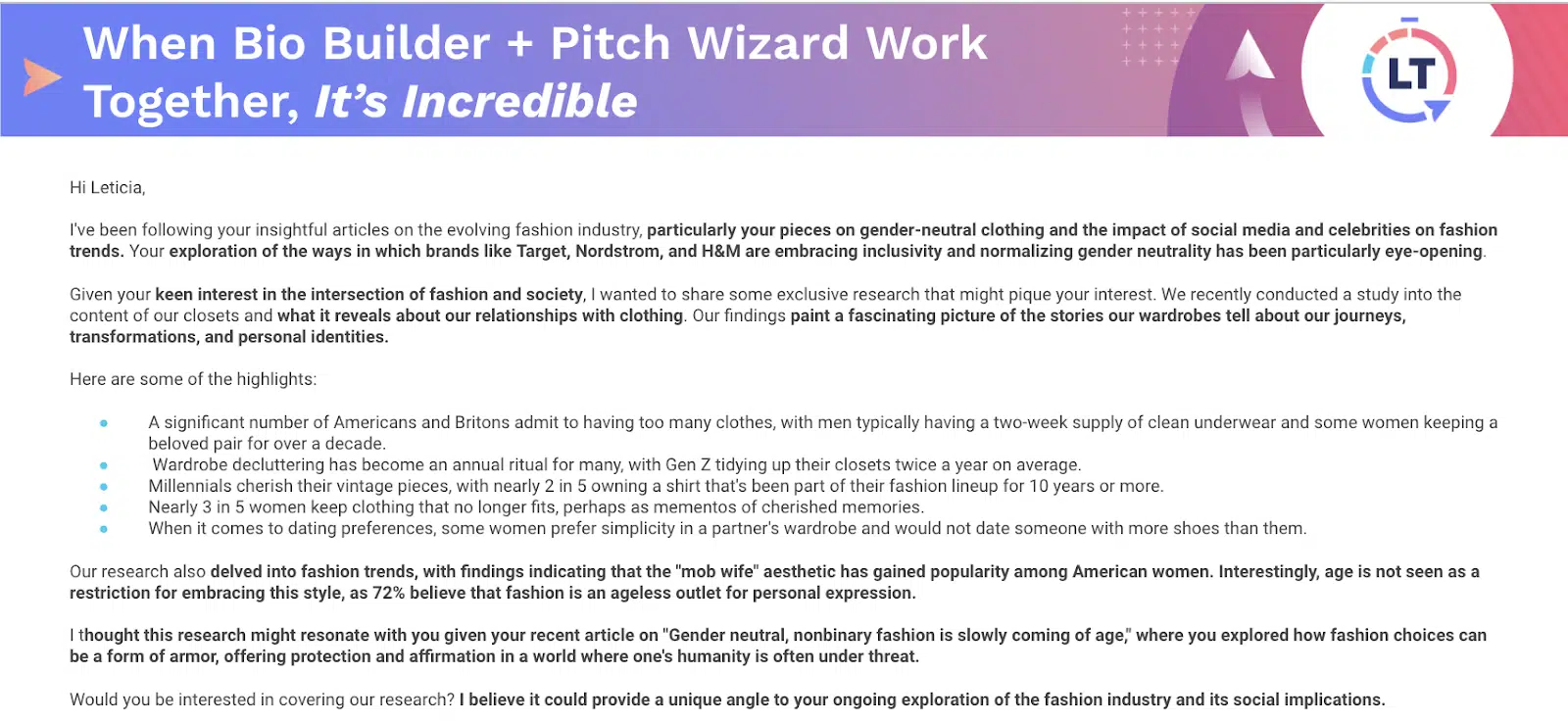
By the end of 2024, the AI workflows had expanded into multiple agents and tools, each crafted to reflect the most refined processes in modern digital PR.
We used these workflows to gain media coverage in top-tier outlets such as Reuters, CNBC, Seeking Alpha, and more, all thanks to AI-driven media lists and pitch strategies.
This year, the choice is clear: you need to learn to wield AI’s marketing superpowers to scale your effectiveness or risk being replaced by AI workflows crafted by industry experts who will outperform your ROI.
While I have mixed feelings about the industry’s rat race to this inevitable future, I don’t feel significant remorse for human robots that fail to adapt.
So where should you begin to apply AI workflows for Digital PR and earned media?
Let’s dive into the new age of marketing.
Understanding the principles of newsjacking
Over 12 years, I’ve audited thousands of our highest-performing content marketing campaigns, and every year there’s a clear trend in the traits that create the most newsworthy brand content:
- Emotionally compelling.
- Timely.
- Educational.
- Entertaining.
- Backed by data.
- Supported by SMEs (subject matter expertise).
The home run happens when a journalist’s interest aligns with your brand’s expertise.
When that journalist spots a trend but lacks the data or expertise to craft a substantive story, you arrive as the source!
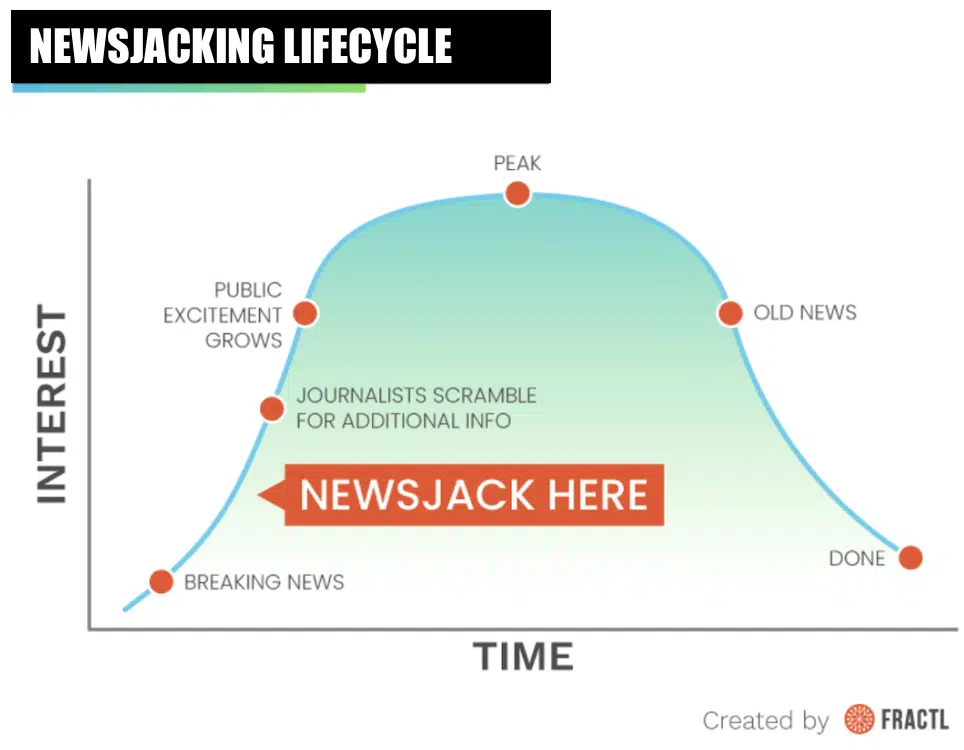
Now think back to the discussions trending in your various social networks over the past year or so – from Slack chats to holiday reunions and everything in between.
Then, consider how our campaign themes (below) capitalized on these trending news cycles by delivering relevant data and expert quotes that resonated with mainstream media based on current consumer interest:
- What is House Poor?
- Using TikTok as a Search Engine
- Inflation’s Impact on [X Holiday]
- Floral Picks for Mom: Top Flowers by State
- Are Retirees Rejoining the Workforce?
- ChatGPT Use in [Y]
- Senior Sentiments on the Modest Social Security COLA Increase for 2024
- Teachers and Parents Weigh in on Back-to-School Spending
- Most Attractive NFL Teams
Looking further back in our database to broaden examples by vertical (below), you can see clear trends in campaigns that broke 100+ earned media placements.
Most of our research was tied to breaking, trending, or cyclical news with mass appeal, allowing our clients to provide exclusive data and expert commentary that helped them earn cross-channel brand exposure across digital, social, TV, radio, and print.
All because we tapped into an emerging national debate or interest piece that was pitched to a handful of leading journalists.
- James Bond Car Morph
- Friends & Family Mooching Subscriptions
- The Truth About Hotel Hygiene
- #SpringBreak Intoxicated
- Consumption and Crime on Campus
- Is Your House Haunted?
In today’s day and age, it’s critical to rely on more than just one marketing channel.
With newsjacking, your brand can tie into timely, culturally relevant conversations, creating the foundation of an omnimedia strategy with KPIs far beyond the SERPs.
Knowing when to leverage reactive PR vs. proactive PR strategies
How do newsjacking, reactive PR, and proactive PR differ?
All strategies are dedicated to putting brands at the forefront of a trending news cycle.
The most important nuance to understand is timing.
Reactive PR: Capitalizing on breaking news
Reactive PR works best for clients or brand teams with high autonomy and the ability to act quickly before news cycles go stale.
Unfortunately, great reactive PR concepts often fail due to slow, bureaucratic processes that require excessive stakeholder approvals.
This either dilutes the original idea or delays execution, causing brands to miss the news cycle or be misaligned with journalists’ interests.
To add value to a breaking news cycle, brands generally need to ideate, research, and pitch within 1-3 business days of a story breaking, preferably less.
As such, ideally, your newsjacking team is staffed with sets of data journalists and digital PR strategists who:
- Are equally passionate about following breaking news.
- Have a wide array of interests.
- Possess superior communication and negotiating skills.
- Thrive in constant, rapidly evolving news cycles with maximum freedom for creativity and strategy development.
And, they’re armed with many agents or prompts to help scale their ideation and workflow.
Common reactive PR methodologies include:
- Short 3-5 question pulse surveys for demographic insights.
- Social scrapes from TikTok, Reddit, or X to extract public sentiment.
- Google Trends monitoring to validate search interest spikes.
- Internal data analysis at larger companies with relevant proprietary data.
- Expert commentary focused on actionable tips for unanswered questions.
- Third-party stories you solicit to support a broader narrative.
In certain verticals – like technology, education, finance, and health – where policy changes and breaking news with mass appeal are abundant, effective reactive PR workflows can significantly impact brand mentions, awareness, and engagement.
Dig deeper: DIY reactive digital PR: How to earn media coverage on a budget
Proactive PR: Aligning with cyclical news
Proactive PR, on the other hand, revolves around tying your brand to annual events or recurring news cycles, for example:
- Major holidays.
- Sporting events.
- Summer break.
- Back-to-school.
- Black Friday.
- Travel Tuesday.
- Tax season.
Ask yourself: What does my target market care about cyclically, and how can my brand be relevant to that?
Then, develop a robust, evergreen content strategy months ahead of that news cycle.
When you pair that content with timely, expert quotes from internal thought leaders, you turn your evergreen resource into a timely, actionable guide with subject matter expertise, pitched as an incredible resource in the weeks leading up to the news cycle.
By monitoring platforms like Qwoted, Bluesky, LinkedIn, and other platforms where journalists actively seek sources (via #JournoRequest), you can easily give your evergreen content a fresh spin (and authoritative links) with minimal PR effort.
Common proactive PR methodologies include:
- Holiday Campaigns: “The Most Haunted [X] in Your State”
- Seasonal Listicles: “X Tips for Decreasing Your Electric Bill in the Winter”
- Timely SMEs: “How To Avoid Identity Theft when Traveling Internationally this Summer”
- Resource Guides: “Blackout Tracker: Understand Your City’s Power Outages”
- Interactive Tools: “Spark Savings: Your Electric Car Calculator”
- Statistic Pages: “50 Statistics Around X”
- Annual Reports: “X Trends in Y Industry in Z Year”
Depending on the overall topic reach and seasonality, most proactive PR campaigns can be promoted several times throughout the year or for at least several weeks before the event.
This provides a longer window of opportunity to earn media than reactive PR, where you’re responding to a breaking news cycle.
Proactive PR is also more widely accepted by larger, more bureaucratic companies that tend to be more conservative and on-brand with their marketing efforts.
Dig deeper: 5 ways to incorporate trends into your SEO content strategy
3 prompts to boost your newsjacking ideation
Our success with AI-driven workflows in media relations has shown that these tools can scale effective strategies by speeding up tasks like list-building and pitch-writing while keeping a personalized touch.
However, AI should be seen as a complement to – not a replacement for – the creativity and intuition of human strategists.
The beauty of “the age of AI in marketing” is that this technology can increase the speed at which brands add value in a breaking news cycle, freeing up human time for more critical work like refining strategies, building relationships, and driving innovation.
As more AI tools become available in the coming weeks, there are several key prompts your PR team should explore to start building impactful AI workflows, particularly for newsjacking.
1. Prompt for newsjacking ideation using trending news
A successful reactive PR campaign relies on your team’s ability to monitor and analyze breaking news at scale – ultimately evaluating what opportunities there are for your brand to add expert commentary or data analysis that could help fill an information gap and further the news cycle.
The prompt (below) arms your team with a plethora of breaking news angles that are relevant for your brand to add commentary to, with boilerplate campaign ideas your content strategists can further refine and execute.
“You’re a digital PR director representing [brand]. Your goal is to identify relevant, authoritative, trending news stories in [topic/industry/region] from the past 24-72 hours. You need to analyze this news cycle to develop Newsjacking campaign ideas that will help your brand earn mainstream media coverage by providing thought leadership or supplementary data analysis that journalists and our target market are interested in within this evolving news cycle.
Tips for research:
- Prioritize stories and themes gaining traction across major outlets or trending on social platforms.
- Seek to identify key concerns, unanswered questions, or recurring themes covered across multiple outlets, highlighting where our brand can add expert commentary.
- Suggest opportunities for gathering unique data through quick pulse surveys, data scraping, or other methods that will help journalists further explore the areas of interest or information gaps in the current news cycle.
- Ensure your ideas are executable within 24-72 hours to remain relevant to the news cycle.
Format your response as follows:
Article Headline
Source URL:Key Takeaways:
- Provide a succinct summary of the most interesting facts, overarching concerns, or unanswered questions.
Newsjacking Ideas:
- Succinct description of idea one
- Succinct description of idea two
- Succinct description of idea three”
Sample output
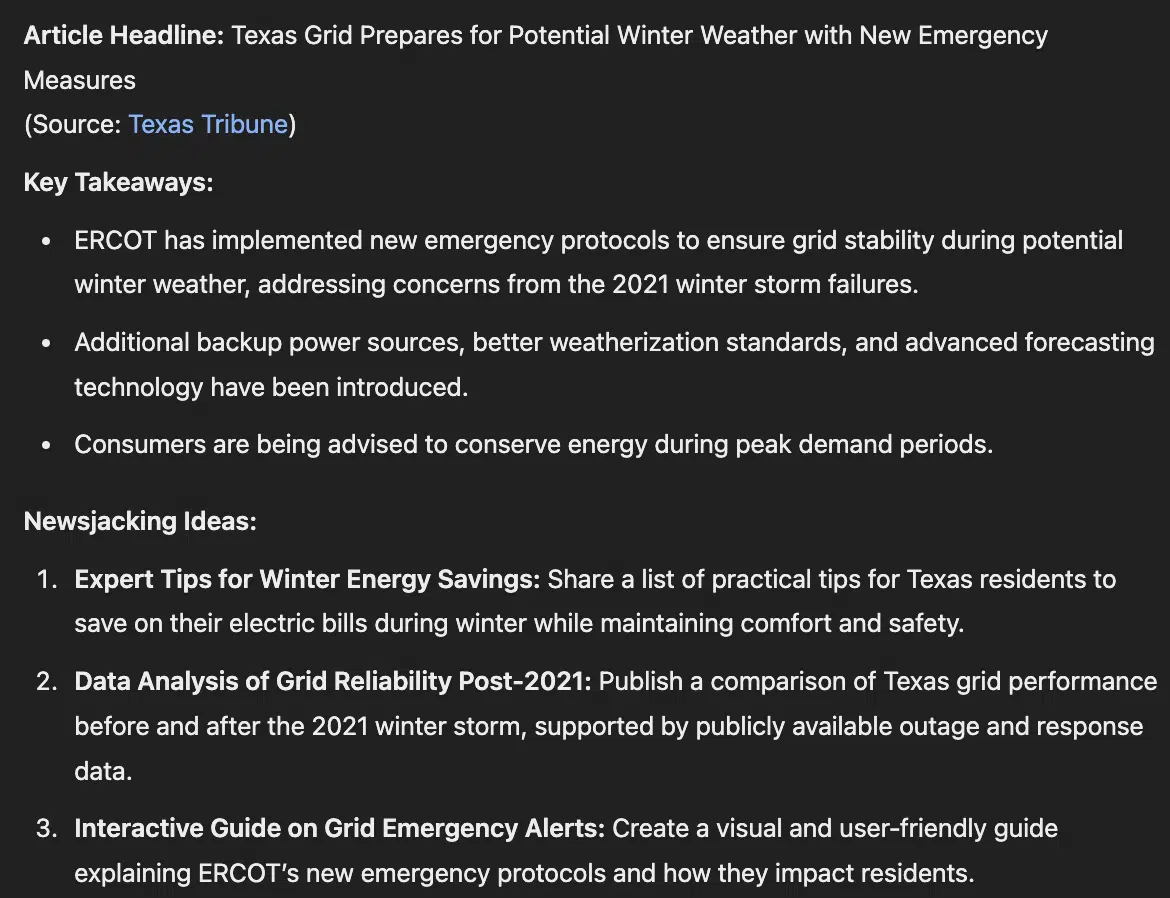
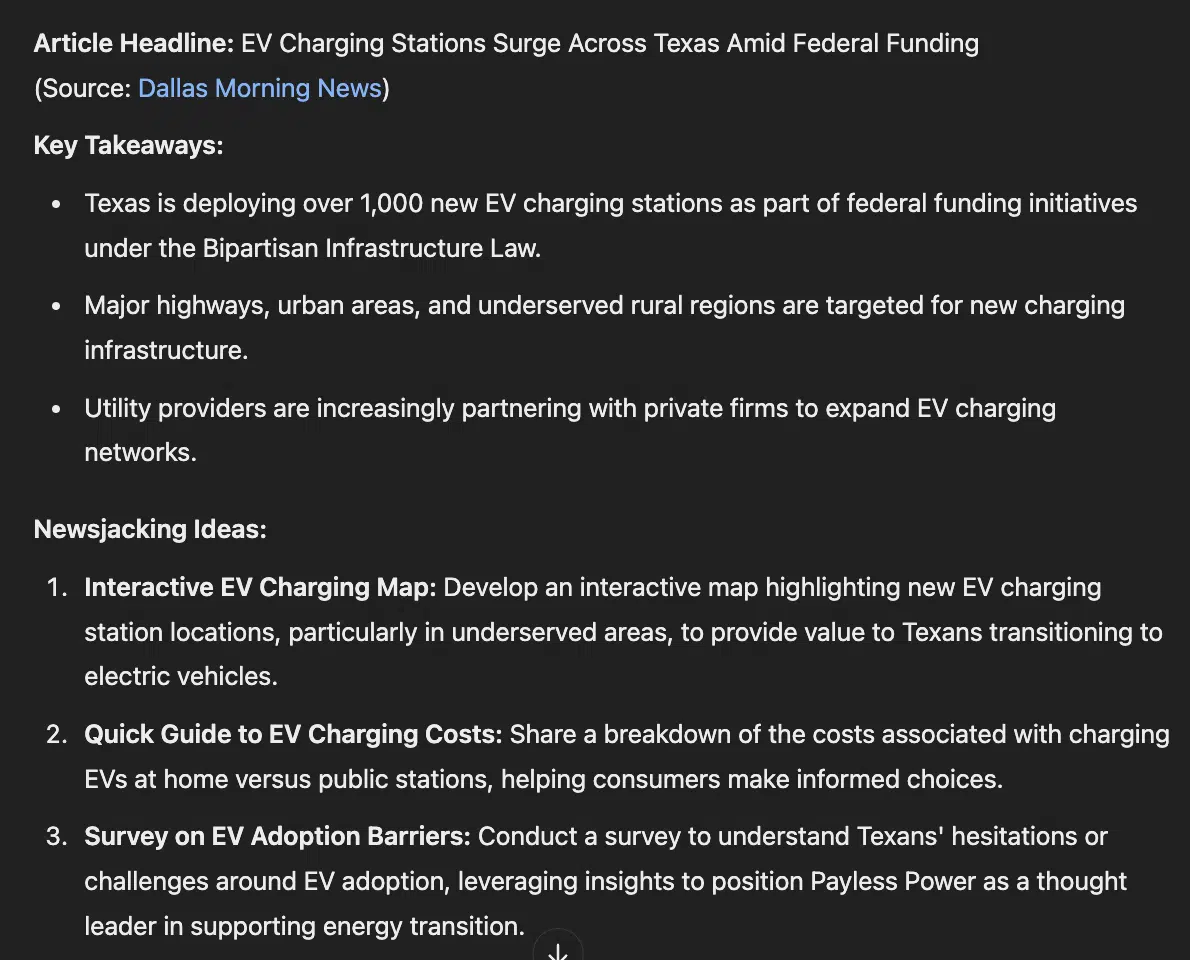
2. Prompt for ideating around news stories circulating internally
Every day, our Newsjacking Slack channel lights up with trending news stories our team feels confident our clients could capitalize on.
Some weeks, our clients will join in the fun, passing along breaking news from industry publications they follow.
If only we had countless hours to read dense, thought-provoking, thousand-word stories; let alone move quickly enough to ideate newsworthy, rapid turnaround methodologies before our competition does.
Whenever you have a time sink challenge, think: How can I solve this with a prompt?
“I represent [Client Name], and we’re focused on [XYZ if lesser known].
I was sent this story by the leadership team (pasted below, under STORY).
Do you see a potential for a newsworthy, data-driven, content marketing campaign inspired by this news that could help our client earn mainstream media coverage? If so, please come up with a headline and brief methodology for the campaign(s) you recommend pursuing.
Focus on timely data acquisition and analysis that will help expand upon the narrative from the story I’ve shared, answer concerns that were raised, or seek to add expertise or insightful data analysis through subject matter experts, data scraping, surveys, and other common newsjacking methodologies.
STORY:
[Paste story here.]”
Sample output
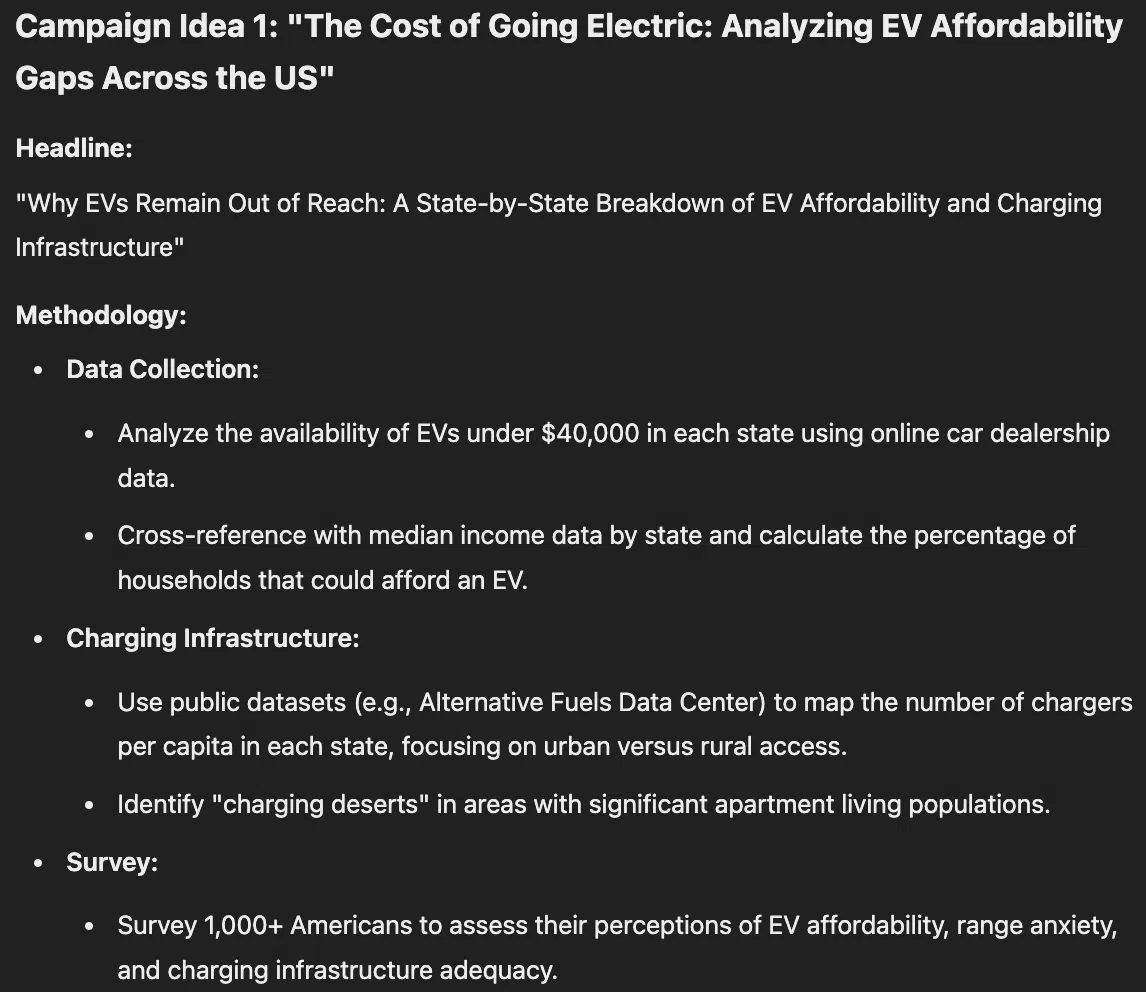
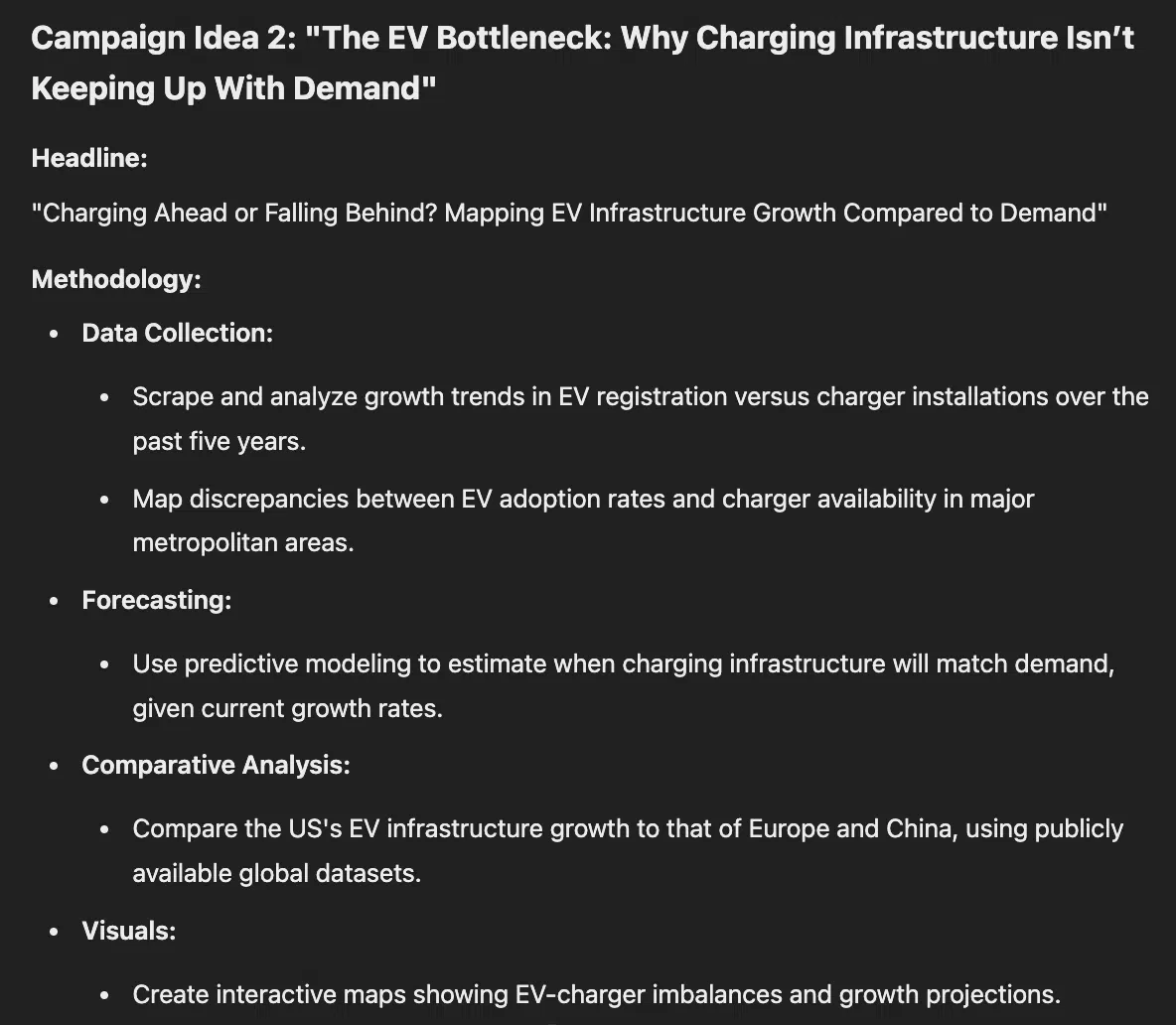
3. Prompt for ideating concrete ideas around trending news you’re already aware of
Sometimes, you’re aware of the trend before anyone else is. (Thanks, TikTok!)
But maybe you stayed up too late scrolling, and now you need your favorite AI sidekick to help you flesh out a newsworthy campaign idea to capitalize on this trend.
After all, it’s better to demonstrate to management that you’re prepared with interesting, actionable campaign ideas, not just a concept of what’s trending.
In this case, you can go with a simpler prompt:
“Suggest five data-driven campaign ideas related to [topic], inspired by current news. Include the type of data required (e.g., surveys, Google Trends, social scraping) and how it supports the news angle.”
Sample output
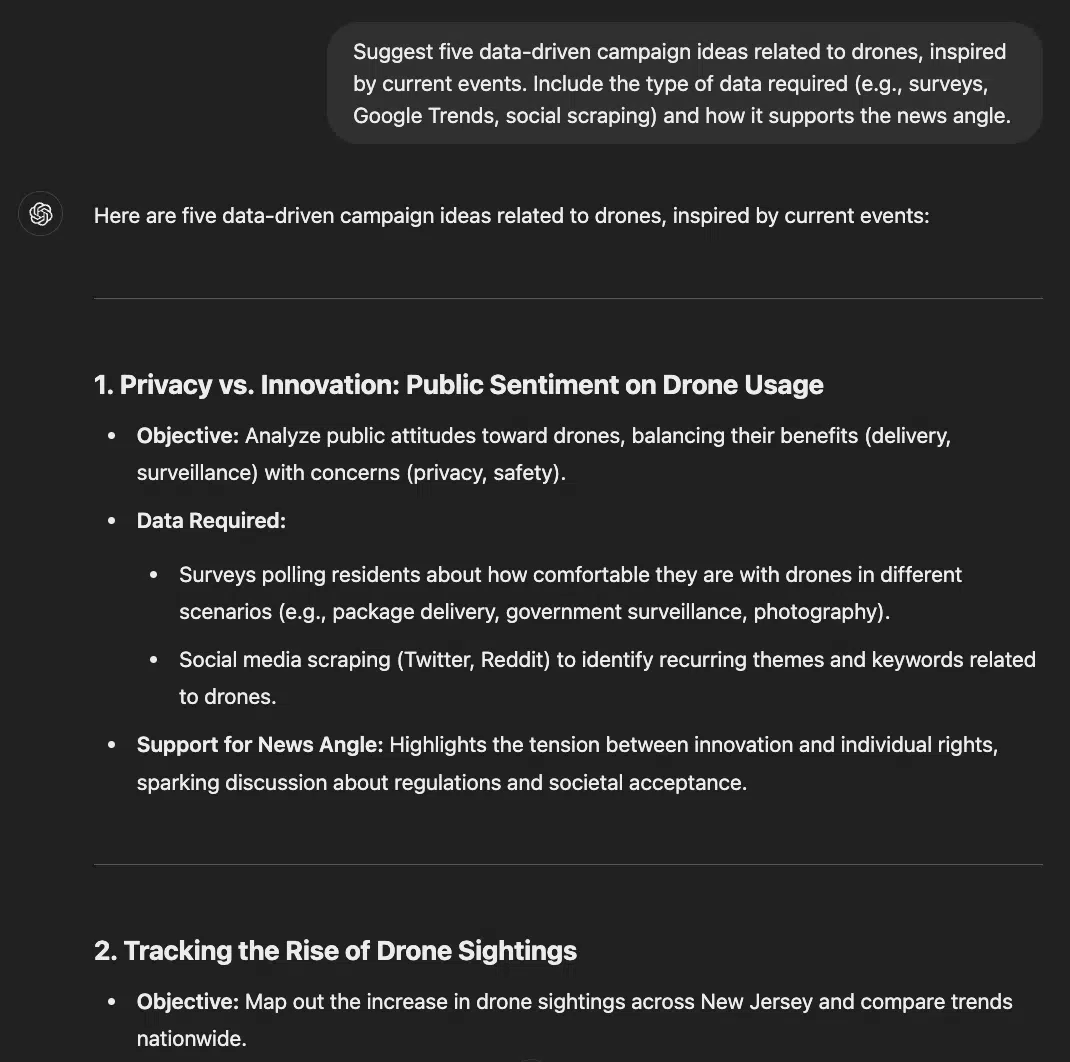
The future of digital PR in the age of AI
The arrival of AI as a disruptive force in digital PR is a double-edged sword.
For those willing to embrace its potential, it’s a superpower that scales creativity, speeds up execution, and unlocks new dimensions of opportunity.
For those resistant to change, it’s a reckoning that could lead to irrelevance in a world that rewards agility and innovation.
The secret to success lies in striking the right balance. Let AI handle the tedious and time-intensive tasks, freeing your team to focus on high-value, strategic work.
I’ve seen firsthand how this approach elevates the quality of our output and redefines what’s possible within the constraints of time and resources.
Will you harness AI to elevate your PR game – or will you be left behind as the industry races forward?
Dig deeper: 5 underrated skills you need to be a good digital PR – and how to master them
Contributing authors are invited to create content for Search Engine Land and are chosen for their expertise and contribution to the search community. Our contributors work under the oversight of the editorial staff and contributions are checked for quality and relevance to our readers. The opinions they express are their own.
Related stories